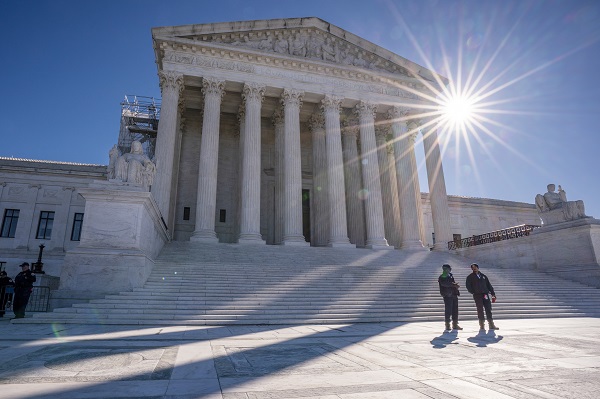By Michael Macagnone
CQ-Roll Call headlines online news
(CQ-Roll Call) — The Supreme Court’s recent decision on South Carolina’s congressional map will make it more difficult for voters to prove state lawmakers improperly relied on race in drawing new congressional lines, advocates and legal experts say.
The opinion laid out a new standard that requires challengers to show that state legislators made their redistricting decisions primarily on the race of voters, not on which party those voters had supported in the past.
It can already be tough for challengers to distinguish between those motivations when racial identification and political affiliation are highly correlated. In the South Carolina case, the civil rights groups who led the challenge said the correlation is particularly true for the state’s Black voters, who tend to support Democratic candidates by large margins.
The Supreme Court decision also says state legislators defending a map in court should get the “benefit of the doubt” that they acted in good faith on political aims rather than unstated race-based reasons.
headlines online news
And the ruling gives states an advantage in those lawsuits unless the challengers present an “alternative map” that would maintain the partisan aims of the redistricting while “producing significantly greater racial balance” between districts.
Advocates said all that will make more difficult the task of proving racial gerrymandering, which is prohibited by the 14th Amendment to the Constitution, as it plays into the complicated confluence of the Voting Rights Act, race and politics.
Rep. Deborah K. Ross, D-N.C., a lawyer and former director of her state’s American Civil Liberties Union, said the Supreme Court decision makes it harder to prove racial discrimination without the “smoking gun” of a legislator saying so publicly.
“They want to hear out of somebody’s mouth ‘We did this 100% to suppress the Black vote.’ Well, that’s not going to happen,” Ross said. “Politicians in this country have been very adept at not saying that — but doing that — since this country was founded.”
Kareem Crayton, the senior director for voting rights and representation at the Brennan Center for Justice, said the ruling means state legislatures, without having to show their work, will have an easier time drawing maps that minimize the power of Black voters and other minority groups.
“What’s troublesome about this case broadly speaking is that it basically tips the scales in favor of legislatures trying to justify maps for a variety of reasons based on partisanship,” Crayton said.
headlines online news
The 6-3 decision, written by Justice Samuel A. Alito Jr. and joined by Republican appointees to the court, followed the broader trend of the court making it more difficult to prove violations of the Voting Rights Act.
Adam Kincaid, executive director of the National Republican Redistricting Trust, said the decision helps clarify how legislatures can draw maps lawfully.
Kincaid argued that state legislatures have had no “safe harbor” between the 14th Amendment, which prohibits racial discrimination, and the Voting Rights Act, which can require legislatures to take race into account in redistricting.
“States should have a set of rules that they can follow to enact maps legally so that not every single map is destined to be overturned in court,” Kincaid said. “For years, no matter what you do, you are going to run up against the rocks of the VRA or run up against the rocks of the 14th Amendment.”
Other experts said the South Carolina decision could have a noticeable effect on future redistricting litigation, but also a limited one.
Nathaniel Persily, a law professor at Stanford Law School and an expert on redistricting, said he doubted the South Carolina decision itself would vastly change redistricting in the near term because “there aren’t that many cases that look like this.”
headlines online news
Most redistricting cases are brought on the theory that a map minimized the power of minority voters, Persily said. Instead, this case hinged on allegations that legislators moved 30,000 Black residents from one congressional district into another because of their race.
A new standard
Alito’s opinion upheld a South Carolina map that moved those residents out of the state’s 1st Congressional District.
A three-judge district court had ruled that was an unconstitutional racial gerrymander because mapmakers moved the Black residents in order to meet a “target” composition of 17% Black. The judges ordered the state to draw a new map.
The Supreme Court reversed the lower court, finding the state had sufficiently argued they moved the voters to keep the district Republican, rather than because they were Black.
To win, the challengers to the map had to “disentangle race” from politics and show that race alone predominated in redistricting, Alito wrote.
“That means, among other things, ruling out the competing explanation that political considerations dominated the legislature’s redistricting efforts. If either politics or race could explain a district’s contours, the plaintiff has not cleared its bar,” Alito wrote.
headlines online news
The lack of an alternative map from the challengers should amount to an “adverse inference” against their case, Alito wrote, and that could dispose of “many, if not most” cases where they lack “direct evidence or some extraordinarily powerful circumstantial evidence.”
Alito used as an example a 1960 case where the Supreme Court noted how a “strangely irregular twenty-eight-sided” district lines showed Alabama’s aim of segregating voters on the basis of race with “mathematical” precision.
A dissent from Justice Elena Kagan and the court’s other two Democratic appointees pointed out the Alabama example shows how big of a roadblock the new map rule could be.
(Please click onto the image of the cat to hear Classic Rock & Oldies)

“The majority must go back 65 years, to the most grotesque racial gerrymander in the U.S. Reports, to find a case based on circumstantial evidence that could have survived its adverse inference,” Kagan wrote. “How better to make the point: The majority’s new evidentiary rule is meant to scuttle gerrymandering cases.”
Kagan pointed out that Alito’s approach lost at the court in another case seven years ago, in a case called Cooper v. Harris where the justices upheld the use of circumstantial evidence to require North Carolina redraw two congressional districts.
“Today, for all practical purposes, the Cooper dissent becomes the law,” Kagan wrote.
Alito, in the decision, said the court had to guard against the use of racial gerrymandering cases, which allege violations of the 14th Amendment’s Equal Protection Clause by discriminating against voters based on race, as end runs to obtain congressional maps with favorable partisan makeups.
What’s ahead
headlines online news
Crayton said the majority of the court seemed willing to allow racial gerrymandering on the margins rather than risk making a decision that would benefit one party or another.
“This court seems more willing to let legislatures break a whole bunch more eggs before you are on notice for possibly being liable as a legislature for violating minority voting rights. That’s the concern,” Crayton said.
Persily said though that the South Carolina decision showed the long shadow cast by the court’s 2019 decision in Rucho v. Common Cause that concluded partisan gerrymandering cannot be challenged in federal courts.
“It does give you a sense of the consequences of Rucho. This was the court embracing partisanship as a reason for drawing lines,” Persily said.
Kincaid pointed out the decision may also have the effect of slowing down some redistricting litigation. Suits brought without 14th Amendment claims, or that have them dismissed, would lose the fast track to the Supreme Court that litigants have used in redistricting litigation in Alabama and other states.
headlines online news
Voting cases with constitutional claims are first decided by a three-judge panel, and that can be appealed directly to the Supreme Court instead of going through a circuit court of appeal. Those with only Voting Rights Act claims do not have that same fast track.
Crayton and others said Congress may have ways to indirectly address the decision, but has few options given that the court decided it based on interpretations of the Constitution.
For years, they and other advocates have pushed for passage of a new Voting Rights Act, which could reinstate prior review for election law changes in several states with a history of racial discrimination.
Crayton said that framework could give challengers more evidence to use in their court cases.
Persily said that doesn’t seem likely, however.
“When it comes to elections, or even public policy in general, it is not like Congress is rushing to pass bipartisan solutions,” Persily said.
©2024 CQ-Roll Call, Inc., All Rights Reserved. Visit cqrollcall.com. Distributed by Tribune Content Agency, LLC.
headlines online news


